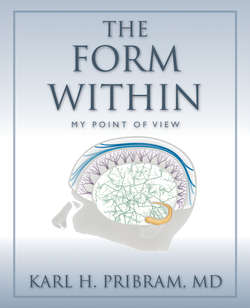Читать книгу The Form Within - Karl H Pribram - Страница 71
На сайте Литреса книга снята с продажи.
Movements
ОглавлениеThe end of the previous chapters left feature creatures with stick figures and frequency freaks with a potential of wavelets. Stick figures are two-dimensional, but the world we navigate is four-dimensional. Nor is that world composed of wavelets; it is filled with objects. Nor is that world composed of wavelets filled with objects. Early on I had the intuition that somehow movement might be the key to unveiling the process by which we are able to perceive objects in a four-dimensional world. My intuition was based on the observation that adjacent to—and sometimes overlapping with—those areas of the brain that receive a sensory input to the brain, there are areas that, when electrically stimulated, produce movements such as turning the head and eyes, perking the ears, and moving the head and limbs. Such movements are mediated by our brain’s circuitry, its surface structure.
But how would our perception of objects be achieved through movement? While teaching at Georgetown, two of my undergraduate students were to provide the route by which I came to a first step toward answering this question. One student kept insisting that he wanted to know “the how, the particular go of it.” Another student in a different class had a condition called “congenital nystagmus.” Nystagmus is the normal oscillation of our eyeballs. In people such as my student, the oscillation is of much greater amplitude and is therefore quite noticeable. I had had several patients with this harmless “symptom,” and I told my student that she had nothing to worry about. This turned out to be a bigger worry to her: she no longer had an ”ailment” that made her special. During class, while I was lecturing on another topic, from time to time I also looked at this student’s big brown oscillating eyes. I began to have the feeling that those eyes were trying to tell me something. Shortly, while still lecturing, the first part of the answer came: I recalled that the ability to perceive at all depends on oscillatory movements.
Experiments have shown us that when the oscillation of the eyes is nullified, vision disappears within 30 seconds. In the experiments, a small mirror was pasted on the test subject’s sclera, the white part of the eyeball. This is not as uncomfortable as it might seem. The sclera is totally insensitive to touch or pain; it is when the cornea, the colored ring around the pupil of our eye, is injured, that it hurts so much. A figure is then projected onto the mirror and reflected from that mirror onto a surface displayed in front of the subject. Thus, (when corrected for the double length of the light path to and from the eye) the figure displayed on the surface in front of the subject mirrors the excursion of the eyeball. Shortly, the subject experiences a fading of the figure, which then disappears within about 30 seconds. Hence, as this experiment clearly demonstrates: no oscillatory movement, no image.
These same results have been repeatedly obtained in experiments involving other senses. Fine oscillations of our receptors or of the stimulating environment around us are needed in order for us to see, to feel by touch, and to hear. These oscillations—vibrations measured in terms of their frequencies—allow us to experience images in the space-time that surrounds us.
The nystagmoid oscillations of the eyes act like a pendulum. The arc that a pendulum describes moves back and forth across a point where the pendulum comes to rest when it stops swinging. Current mathematical descriptions call such a point an “attractor.” (Mathematically, the ideal point attractor is defined as an essential character of a system of group-theoretical oscillations that in time converge on it.) Thus the oscillations of the eyes form a point attractor in the neuro-nodal deep structure of fine fibers that can then serve as a pixel. Pixels are the units from which the images on your television screen are formed.
Forming a point attractor, a pixel, from oscillations is a transformation. The transformation converts the frequency of oscillations in the spectral domain to points in space-time. In short, the transformation is described by the (inverse) Fourier equation. It is the oscillatory movements, because of their pendulum-like character, that transform a distributed holographic-like brain process to one that enables imaging. Converting from space-time to frequencies and back to space-time is the procedure that is used to produce images by PET scans and fMRIs in hospitals.
